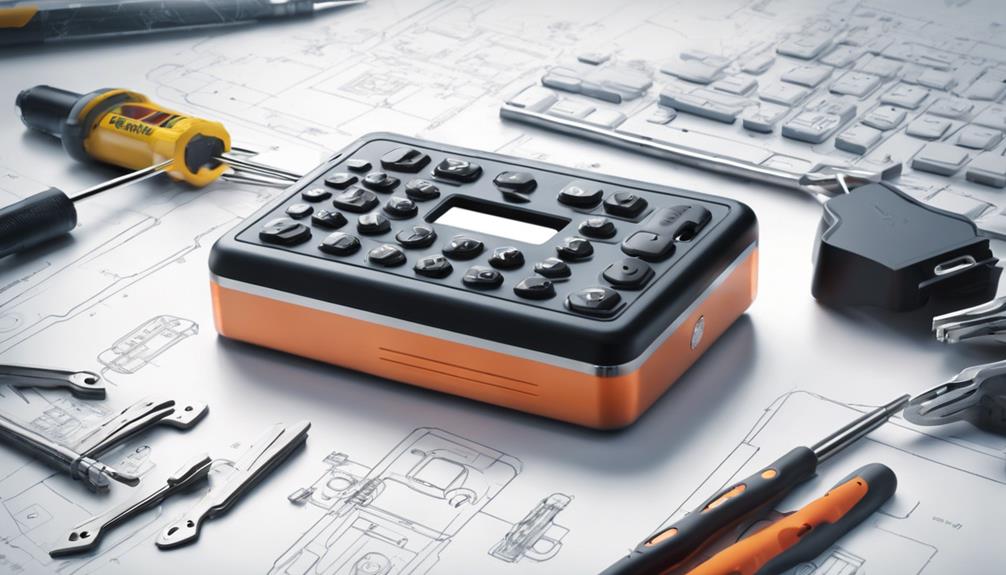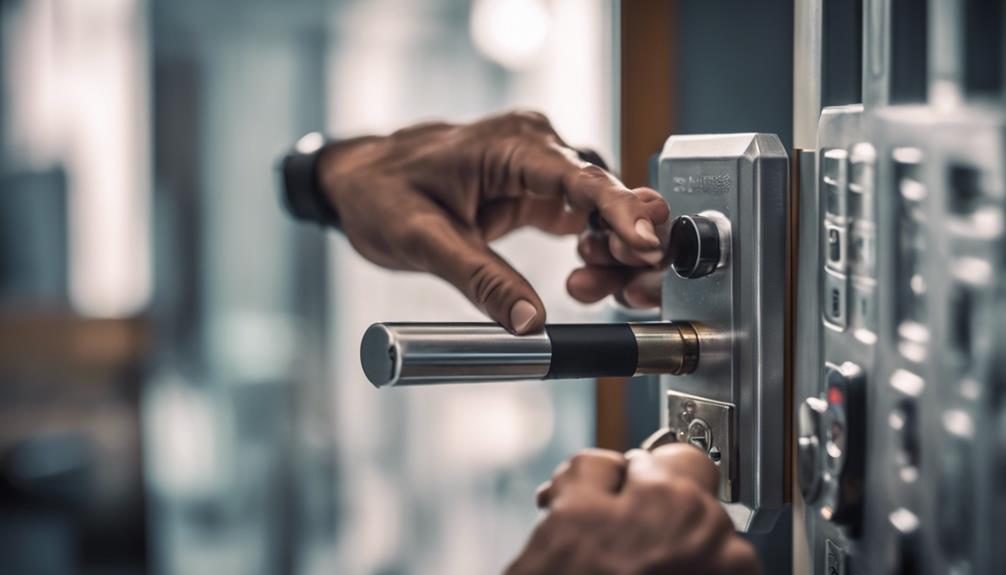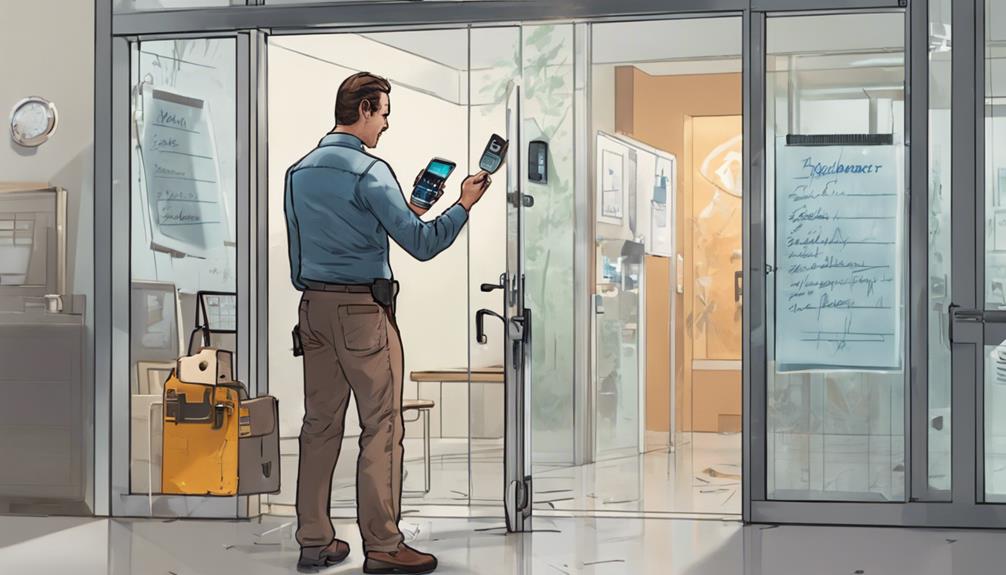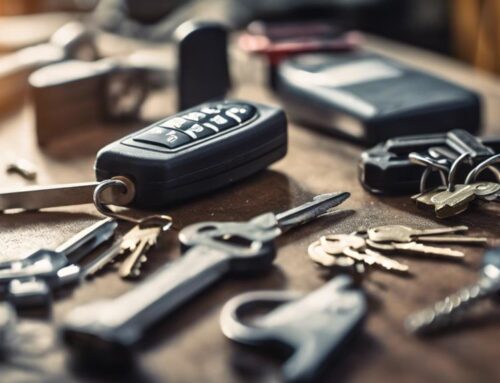Much like a scene from a suspenseful thriller, an unexpected electronic lock malfunction can leave you feeling trapped and anxious. When faced with this scenario, your first steps are vital—check the power source and inspect the lock for any visible damage. But what if that doesn't work? Understanding how to troubleshoot effectively and prevent future lockouts is essential for maintaining smooth operations in your business. The key lies in proactive measures and smart upgrades, which can transform your security approach. So, what strategies will you implement next?
Key Takeaways
- Check the power source and inspect lock components for damage or wear to identify potential malfunctions early.
- Reset device settings according to the manual to resolve temporary glitches affecting lock functionality.
- Conduct regular maintenance checks to spot potential issues before they escalate and lead to lockouts.
- Consider upgrading to modern electronic locks with better security features and remote access capabilities.
- Establish a reliable locksmith service for emergencies to ensure quick resolution during lock malfunctions.
Identify the Malfunction Symptoms

When you encounter electronic lock malfunctions, recognizing the symptoms early can save you time and hassle. Pay close attention to malfunction indicators such as inconsistent lock behavior. If your lock refuses to engage or disengage properly, it's a clear sign something's amiss. You might notice delays in response time or the lock failing to recognize your access credentials. Additionally, unusual sounds or lights can signal deeper issues. Understanding these indicators allows you to assess the situation effectively and take necessary precautions. Ignoring these symptoms could lead to more significant problems, jeopardizing security and access. By being proactive and vigilant, you maintain control over your locking systems, ensuring smooth operations within your business.
Troubleshooting Steps to Take
When facing issues with your electronic lock, start by checking the power source to guarantee it's functioning correctly. Next, inspect the lock components for any visible damage or wear that could hinder performance. Additionally, considering the evolution of authentication methods, integration with smart home systems can enhance convenience and security. Finally, consider resetting the device settings, as this can often resolve temporary glitches.
Check Power Source
A malfunctioning electronic lock can often trace its issues back to a simple power failure. Start by conducting battery checks; a weak or dead battery could be the culprit. Make certain you're using high-quality batteries compatible with your lock model. If your lock is hardwired, inspect the power supplies to confirm they're functioning correctly. Look for any signs of damage, loose connections, or tripped breakers. If you've recently experienced fluctuations in power, it might be wise to invest in surge protectors or uninterruptible power supplies (UPS) to safeguard your electronic locks. By prioritizing these checks and considering the affordable 24-Hour Mobile Locksmith service nationwide, you can address power-related issues efficiently and minimize the risk of future lockouts in your business, making sure a seamless entry experience for you and your team.
Inspect Lock Components
After confirming that the power source is functioning properly, the next step is to inspect the lock components themselves. Examine each part for signs of wear, which can compromise the lock's functionality. Check the locking mechanism, hinges, and any electronic sensors, making sure they're free from debris and functioning smoothly. Regular routine inspections are vital; they help you identify potential issues before they escalate, allowing for proactive maintenance. Pay close attention to the alignment of components, as misalignment can lead to failure. If you notice any signs of damage or excessive wear, consider replacing the affected parts immediately. By maintaining vigilance over your lock components, you can mitigate the risk of future lockouts and guarantee your business remains secure.
Reset Device Settings
How often do you find yourself troubleshooting electronic locks? When malfunctions occur, a factory reset can often restore functionality. Here's a concise guide to reset device settings:
- Consult the Device Manual: Locate the troubleshooting section for specific reset instructions. If you need further assistance, many manufacturers offer online resources with detailed troubleshooting tips.
- Power Down the Device: Disconnect the power source to guarantee a complete refresh.
- Initiate Factory Reset: Follow the manual's steps, which usually involve pressing a combination of buttons or a specific sequence.
- Reconfigure Settings: After the reset, set up your preferences again, as all previous settings will be erased.
Contacting Professional Help

When your electronic lock continues to malfunction despite troubleshooting, it's time to contemplate contacting a professional. You'll want to identify reliable technicians who can address the specific issues you're facing, while also factoring in the costs and estimates involved. Understanding when to call for expert help can save you time and guarantee your security needs are met efficiently.
When to Call Experts
Knowing when to call in experts can save you time and prevent further complications with your electronic lock. Here are key scenarios to take into account:
- Repeated Failures: If your lock malfunctions frequently, it's time for a security assessment to identify underlying issues. For businesses aiming to meet security compliance standards, addressing these issues promptly is vital to Securing Compliance.
- Inability to Access: If you can't open the lock after multiple attempts, immediate emergency response is essential to regain access.
- Strange Noises or Lights: Unusual sounds or indicator lights can hint at deeper electronic problems that require professional insight.
- Software Issues: If the lock's software updates fail or are unresponsive, a technician can diagnose and rectify these technical glitches.
Acting swiftly can enhance your security and guarantee your business remains operational.
Identifying Reliable Technicians
After recognizing the need for professional assistance, the next step is to identify reliable technicians who can effectively address your electronic lock issues. Start by vetting their technician qualifications, which should include relevant certifications and experience in electronic locking systems. Check for customer reviews and testimonials to gauge their service reliability. A reputable technician should also offer warranties on their work, demonstrating confidence in their skills. When reaching out to multiple candidates to compare their responses and expertise, ascertain you find one that aligns with your business needs. By being thorough in your selection process, you'll secure a technician capable of resolving your electronic lock problems efficiently, preventing future disruptions and safeguarding your operations. For more tips on choosing the right locksmith for your business needs, refer to Choosing the Right Locksmith for Your Business Needs for additional insights.
Cost Considerations and Estimates
Understanding the costs associated with electronic lock repairs is essential for effective budgeting. To guarantee you're prepared, consider these key factors in your budget planning:
- Service Fees: Initial consultation or service call fees from technicians can vary greatly. It's important to factor in these costs to maintain ideal security for your business.
- Repair Costs: Depending on the malfunction, repairs can range from minor adjustments to complete component replacements.
- Installation Costs: If you're upgrading or replacing the lock, factor in the installation costs, which may include labor and materials.
- Preventative Maintenance: Regular check-ups can mitigate future issues, but they come with their own costs.
Importance of Regular Maintenance
Regularly maintaining electronic locks is vital for ensuring their reliability and security. By implementing effective preventative measures, you can markedly reduce the risk of malfunctions that could compromise your business's safety. Establishing maintenance schedules is important; they allow you to routinely inspect and service your locks, ensuring they function at their best. During these inspections, pay attention to battery life, software updates, and mechanical components. Identifying potential issues early prevents costly repairs and inconvenient lockouts. A proactive approach not only safeguards your assets but also reinforces your authority in managing security systems. Prioritizing regular maintenance empowers you to maintain control over your business environment, ensuring that electronic locks remain a dependable barrier against unauthorized access. Additionally, implementing a thorough maintenance program can help prevent lock failure and reduce the risk of break-ins, as discussed in Essential Lock Maintenance for Business Security.
Upgrading Your Electronic Locks

While maintaining your electronic locks is critical for their continued performance, upgrading them can greatly enhance your security measures. By integrating the latest smart lock features, you can guarantee that your business remains at the forefront of electronic security trends. Here are four compelling reasons to evaluate an upgrade:
- Enhanced Security: Modern locks offer superior encryption and authentication methods.
- Remote Access: Control and monitor your locks from anywhere via mobile apps.
- User Management: Easily add or revoke access for employees without physical keys.
- Audit Trails: Track who accessed areas and when, improving accountability.
Investing in upgraded electronic locks not only strengthens your security but also provides you with greater control over your premises.
Implementing Access Control Systems
As you consider bolstering your security infrastructure, implementing access control systems can be a game-changer for managing who enters your premises. These systems not only enhance security but also streamline access through biometric authentication, guaranteeing that only authorized personnel can enter sensitive areas. By leveraging advanced technologies, you can monitor and control access in real-time, providing you with valuable insights into your operations.
Moreover, integrating remote access capabilities allows you to manage entries from anywhere, giving you unparalleled control over your premises. You'll reduce the risk of unauthorized access while simplifying the process for your team. Investing in robust access control systems will empower you to maintain a secure environment, minimize potential breaches, and guarantee peace of mind for your business.
Low Rate Locksmith Services

When you're seeking reliable security solutions, low rate locksmith services can offer an affordable alternative without compromising quality. These services provide essential support, particularly during unexpected situations. Here's how to evaluate your options:
- Research Local Providers: Look for locksmiths with good reviews and transparent pricing.
- Inquire About Emergency Services: Confirm they offer 24/7 assistance for immediate lockout situations.
- Compare Quotes: Analyze different locksmiths to identify the most cost-effective solutions that meet your needs.
- Check Credentials: Verify that the locksmith is licensed and insured to avoid potential scams.









